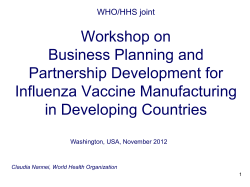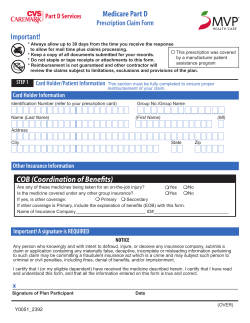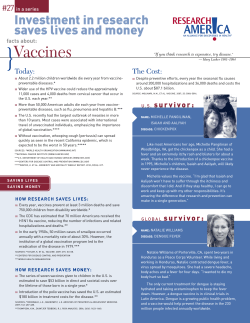
View the Poster as a PDF file - EGG
9th INTERNATIONA SYMPOSIUM ON AVIAN INFLUENZA – ATHENS, GA, USA – APRIL 12-15, 2015. Experimental and field results on the immunity induced by a rHVT-HA vector vaccine against H5N1 and other H5 type Highly Pathogenic Avian Influenza Viruses. Yannick Gardin 1, Vilmos Palya 2, Kristi Moore Dorsey 3, Francesco Bonfante 4, Darrell Kapczynski 5, Walid Hamdy Kilany 6, Fabienne Rauw 7, Retno D. Soejoedono 8. 1 Ceva Animal Health, Libourne, France. 2 Ceva Animal Health, Budapest, Hungary. 3 Ceva Animal Health, Lenexa, KS, USA. 4 Istituto Zooprofilattico Sperimentale delle Venezie, Legnaro (Padova), Italy. 5 Southeast Poultry Research Laboratory, United States Department of Agriculture, Athens, GA, USA. 6 National Laboratory for Veterinary Quality Control on Poultry Production, Animal Health Research Institute, Giza, Egypt. 7 Avian Virology and Immunology Unit, Veterinary and Agrochemical Research Centre (VAR), Ukkel (Brussels), Belgium. 8 Faculty of Veterinary Medicine, Bogor Agricultural University, Bogor, Indonesia. Abstract Vaccination against H5N1 Highly Pathogenic Avian Influenza Virus (HPAIV) is one of the possible means available for affected countries to control the disease once it has become endemic. Efficacy of vaccination against AI relies essentially, but not exclusively, on the capacity of the vaccine to induce immunity against the targeted virus (which is prone to undergo antigenic variations) as well as its capacity to overcome interference with maternal immunity transmitted by immunized dams to their progeny. This property of the vaccine is a prerequisite for its administration at the hatchery, which assures higher and more reliable vaccine coverage of the chicken populations than vaccination at farm. A vector vaccine (Vectormune AI) based on HVT carrying the haemagglutinin gene of an H5N1 HPAIV as an insert, has been used in several experiments conducted in various research laboratories as well as in controlled field studies. The results have demonstrated high degree of cross protection against various genetic clades of the H5N1 HPAIV and high degree of efficacy was even observed against challenge with the 1994 Mexican H5N2 HPAIV as well as the more recent 2014 Germany H5N8. Furthermore, active immunity induced by this vaccine was not impaired by the presence of passive immunity, but on the contrary, cumulated with it for improved early protection. The recorded levels of protection against the different challenge viruses showed some variations in terms of post-challenge mortality as well as challenge virus shedding. Although this should be further investigated, it is believed that this was probably more attributable to the variability in trials conditions, materials, methods and results, rather than variations in immunizing capability of the vaccine against various H5 strains of HPAIVs. The data highlight the possibilities offered by this vaccine to be used as a useful and reliable tool to complement biosecurity and sanitary policies for better controlling the disease due to H5 type AI. Introduction The 3 main issues associated with vaccination against Avian Influenza are: -Antigenic variability of the challenging virus affecting efficacy of classical inactivated vaccines, -Interference of Maternally Derived Antibodies (MDA) with classical inactivated vaccines, preventing early vaccination at the hatchery. -Necessity to reach high vaccine coverage at the flocks level, which can hardly be achieved when vaccination is done at the farm (15). The rHVT-HA vector vaccine (Vectormune AI) is a recombinant vaccine constructed from the FC126 strain of HVT inside the genome of which, in a region recognized as non essential for the growth of the virus, a cDNA sequence encoding for the HA of a clade 2.2 H5N1 HPAIV (A/swan/Hungary/4999/2006) has been inserted together with a CMV promoter to control the expression. For safety reasons, the HP cleavage site of the HA gene has been modified into a LP one. This vaccine has been officially licensed by USDA in the USA in 2012, and from there in other countries. Since then, to complement information included in the original registration file, many scientific investigations, controlled trials and field studies have been conducted to increase our knowledge regarding its characteristics and performances, so that prescription and decision for usage can rely on broader information. Besides, field experience from large commercial use has also enriched our experience. The objective of this poster is to present a brief overview of the data from various experiments conducted so far, and some of the conclusions to be drawn regarding the practical usage and monitoring of performance. Immune response to vaccination and challenge (see figure 1) After vaccination of SPF chickens, this rHVT-HA vaccine induces antibodies (AB) clearly detectable by HI Test, as soon as 3 weeks post vaccination in the majority of the tested animals, with titer values reaching 5 to 6 log2 if an homologous antigen is used. This antibody response keeps on increasing until at around 9 weeks of age, and then reaches a plateau with titer values of 9 to 11 log 2. In commercial chickens provided with passive immunity against HVT and AIV (H5N1 or H5N2), under similar conditions of testing, antibody response is slower to rise and reaches lower HIT titer values at all time points. Experiments have shown that a high level of protection is reached before homologous HIT antibodies are detected in all chickens. When using antigen heterologous to the vaccine but homologous to the challenge virus, the detected level of antibody before challenge is generally low but has no predictive value regarding protection. It is thus concluded that other components of the immune response triggered by this vaccine, and, in particular the cellular and mucosal ones, play an important role (3, 4, 6). After challenge, a clear rise in heterologous HIT antibody titers is observed. The rise in homologous HIT antibody titre is more limited and variable, and, in case of early challenge, can hardly be systematically attributed to challenge virus replication since a rise of similar intensity is also observed in vaccinated but non challenged chickens, as a continuation of the natural antibody response development (10, figure 1). The use of other serological tests specific to the anti-NP or anti-M2 antibodies induced by the replication of a “full” virus, does confirm this statement: in some experiments, only few vaccinated and challenged chickens turned positive when these assays were used, indicating no or little replication of the challenge virus (9, 10). The use of such test in rHVT-HA vaccinated flocks allows for a DIVA monitoring strategy of detection and eradication. Figure 1: monitoring of antibody response to vaccination with a rHVT-HA vaccine in commercial layer pullets provided or not with MDA against HVT and H5N1 AIV (Ceva Scientific Investigation Study ref. SCI 193-2011) Immune response to vaccination and challenge (see table 1) 2 criteria are considered as important regarding protection: clinical signs (mortality and morbidity) and shedding of the challenge virus after inoculation Table 1 gives a simple overview of the protection results collected through various experiments conducted with rHVT-HA. In all experiments, chickens were vaccinated with a single dose of vaccine injected subcutaneously at dayold and challenge was given between 2 to 8 weeks of age (except one experiment at 19 weeks) with a dose of 106 EID50 of challenging virus (except in experiment conducted by D. Perez at U. of Maryland where 105EID50 was used). Protection against mortality was generally good to very good, varying from 60% to 100% , including against challenge with HPAIV strains of different clades of H5N1, or different serotypes (H5N2, H5N8) with significant distance regarding homology of the HA genes. This allowed concluding to “cross clades protection against HPAIV of the H5 type”. Reduction of shedding considering the percentage of shedders as well as amount of virus shed was always observed but with different intensities. It is believed that the different experimental conditions as well as the different techniques used to detect and quantify re-excretion (RT-PCRs of different types, virus isolation) explain these variations (in table 1, reported percentages of shedders 2 or 3 days post challenge are given as an illustration, although not readily comparable from one experiment to another). Table 1: compilation of protection results collected through various experiments conducted with rHVT-HA (Vectormune AI) vaccine. Please refer to corresponding publications for details. Location Vaccination MDA against: Type of HVT AIV Location Country chickens U. Maryland USA SPF No No Coda-Cerva Belgium COM BR Yes No Coda-Cerva Belgium COM BR Yes Yes (H5N2) Coda-Cerva Belgium COM BR Yes Yes (H5N2) Coda-Cerva Belgium SPF No No Coda-Cerva Belgium SPF No No Coda-Cerva Belgium COM BR Yes No Coda-Cerva Belgium COM BR Yes Yes (H5N1) Coda-Cerva Belgium COM BR Yes Yes (H5N1) Coda-Cerva Belgium COM BR Yes Yes (H5N1) Bogor Agr. U.Indonesia COM BR Yes Yes (H5N1) Bogor Agr. U.Indonesia COM BR Yes Yes (H5N1) SEPRL USA SPF WL No No SEPRL USA SPF BR No No SEPRL USA SPF WL No No Coda-Cerva Belgium SPF No No Coda-Cerva Belgium SPF No No NLQP Egypt COM BR Yes Yes (H5N1) NLQP Egypt COM BR Yes Yes (H5N1) Coda-Cerva Belgium SPF No No IZSVe Italy SPF No No CLQP Egypt COM LY WB Yes Yes (H5N1) CLQP Egypt COM LY BS Yes Yes (H5N1) Onset of Immunity (OOI) Challenge S.type H5N1 H5N1 H5N1 H5N1 H5N1 H5N1 H5N1 H5N1 H5N1 H5N1 H5N1 H5N1 H5N1 H5N1 H5N2 H5N1 H5N1 H5N1 H5N1 H5N8 H5N1 H5N1 H5N1 HPAIV Strain A/CK/Viet Nam/1203/2004 A/Duck/Hungary/11804/2006 A/Duck/Hungary/11804/2006 A/Duck/Hungary/11804/2006 A/CK/Egypt/1709-1 VIR08/2007 A/CK/Egypt/1709-6/2008 A/CK/Egypt/1709-6/2008 A/CK/Egypt/1709-6/2008 A/CK/Egypt/1709-1 VIR08/2007 A/CK/Egypt/1709-6/2008 A/CK/West Java Subang/29/2007 A/CK/Puwakarta-Cilingga/142/2010 A/Whooper Swan/Mongolia/3/2005 A/CK/West Java Subang/29/2007 A/CK/Queretaro/14588/1995 A/CK/Egypt/1709-6/2008 A/CK/Egypt/1709-6/2008 A/CK/Egypt/1709-6/2008 A/CK/Egypt-63/2010 "variant" A/CK/Germany/2014 A/CK/Bangladesh/11RS1 984-33/2011 A/CK/Egypt/128s/2012 A/CK/Egypt/128s/2012 Clade 1 2.2 2.2 2.2 2.2.1 2.2.1 2.2.1 2.2.1 2.2.1 2.2.1 2.1.3 2.1.3 2.2 2.1.3 2.2.1 2.2.1 2.2.1 2.2.1 2.3.4.4 2.3.2.1 2.2.1 2.2.1 Route Age IN 4 woa IN 2 woa IN 2 woa IN 3 woa ON 3 woa ON 3 woa ON 4 woa ON 4 woa ON 4 woa ON 4 woa ON 4 woa ON 4 woa IN 6 woa IN 4 woa IN 4 woa ON 4 woa ON 8 woa IN 4 woa IN 5 woa ON 4 woa ON 4 woa ON 19 woa ON 19 woa Protection against : Mortality % Oro-pharyngeal shedders Vacc. Ctr. When Vaccinated Controls 85% 0% 2dpc 30% 100% 90% 0% 2 dpc 20% 38% 100% 20% 2 dpc 0% 60% 90% 0% 2 dpc 0% 80% 100% 0% 3 dpc 80% 100% 100% 0% 3 dpc 100% 100% 90% 0% 2 dpc 10% 100% 100% 0% 2 dpc 10% 90% 90% 0% 2 dpc 100% 100% 70% 0% 2 dpc 90% 100% 80% 0% 2 dpc 60-80% 100% 95% 0% 2 dpc 60-80% 100% 100% 0% 2dpc 13% 100% 80% 0% NT NT NT 95% 0% NT NT NT 100% 0% 2 dpc 70% 100% 100% 0% 2 dpc 40% 100% 93% 0% 2 dpc 40% 100% 80% 0% 2 dpc 55% 100% 100% 0% NT NT NT 100% 0% 2 dpc 10% all dead 73% 0% 3 dpc 0% 100% 60% 0% 3 dpc 7% 100% Ref. 1 2 2 2 3 3 4 4 4 4 5 5 6 6 6 7 7 8 8 9 10 11 11 Duration of Immunity (DOI) Onset of immunity varies according to: - The type of chicken i.e. broilers verses layers: OOI is earlier in broilers. - The presence of MDA against AIV: AB response is earlier in MDA(-) chickens. In chickens free of MDA against AIV, early protection comes exclusively from vaccine replication and 2 to 3 weeks are necessary to reach satisfactory levels, although earlier resistance to challenge has not been tested yet. In chickens with MDA against AIV, protection comes also from passive immunity which is actually protective (13), and it has been observed that active protection induced by vaccination cumulates with passive protection and overall protection is increased. For this reason, in endemic countries, vaccination of breeders against AI complements and does not contradict vaccination of broilers and pullets. Data regarding efficacy of rHVT-HA to protect long living chickens against very late challenge are not available yet. However, the following elements are suggesting of a long lasting protection: - HVT is known to persist forever in infected animals, so that expression of the HA inserted inside the rHVT-HA vaccine is likely to persist as well as corresponding induced protection. - Monitoring up to 12 weeks of age of HIT AB response (homologous antigen) to rHVT-HA (Vectormune AI) vaccination of commercial layer pullets provided or not with MDA against H5N1 revealed showed titers increasing and then keeping steady. - Layer pullets of 2 different breeds, vaccinated at the hatchery and reared under the heavy diseases challenge conditions of Egypt, were transferred at 19 weeks of age to BSL3 facilities for virulent challenge. Protection levels of 73% and 60% were recorded (11). - A very strong protection (no mortality, no clinical signs, no drop in egg production) against challenge with very virulent Newcastle Disease Virus was observed up to 72 weeks after a single injection on the first day of age of a commercial dose of a rHVT-F (Fusion gene – similar to rHVT-HA) Newcastle Disease vaccine to pullets provided with MDA (16). Target species Experiments have demonstrated replication of rHVT-HA , expression of the HA antigen and induction of protection in chickens of the SPF, broiler and layer types, as well as in turkeys (14). Replication has also been evidenced in waterfowls of the Goose, Muscovy ducks and Mallard ducks types. Surprisingly, very reduced replication and no protection were observed in Peking ducks (12). Replication was also observed in quails and pheasants but not in pigeons (Ceva registration dossier). Conclusion In 2012, a rHVT-HA (Vectormune AI) vaccine against Avian Influenza due to H5 AIVs was first licensed in the USA and since then made commercially available in various countries where the disease is endemic (Egypt, Bangladesh, Mexico), but, for local administrative reasons, not yet all. Protection induced by this vaccine, following a single injection to day-old chicks at the hatchery, has been tested in various locations, by independent researchers, under various experimental and field conditions against challenges using various clades of the H5N1 HPAIV (1, 2, 2.2, 2.2.1, 2.1.3, 2.3.2.1, 2.3.4.4) as well as against H5N2 (Mexico 1994) and H5N8 (Germany 2014) HPAIVs. In all cases, and despite the sometimes notable genetic divergences observed between the HA used for the construction of the vector vaccine and the HA of the challenging HPAIV, protection against mortality and clinical signs has revealed very good, with variable, but constant, reductions in the shedding of the challenging virus considering both the percentage of excreting chickens and the amount of virus shed. It is believed that this is the first commercially available vaccine showing this cross clade protection property, and consequently, a real remedy to the continuous antigenic variations of the field virus. Replication and onset of immunity have been regularly observed, in all kinds of chickens (SPF, commercial layers, commercial broilers), provided or not with various levels of MDA against HVT, MDV and AIV (H5N1, H5N2). Because of all these characteristics as well as because of the possibility of a semi-automatic injection in the hatchery, which is the only practical way to reach a high percentage of vaccine coverage (up to 98%), it is believed that this rHVT-HA vaccine is an extremely powerful tool to vaccinate against Avian Influenza caused by H5 type AIVs. Because of its subunit antigenic nature, its use does not interfere with a serological detection based (DIVA) eradication strategy. However, at the farm as well as at the region of country levels, just like for other vaccines, the benefits drawn from using this rHVT-AI vaccine will depend on the quality of application, the quality of the chicks, management, feed and farming, the occurrence of other concomitant infections or immune-depression factors as well as the coherence of its use with implementation of the necessary biosecurity and control policies. References 1- Perez D. (2008) Efficacy study - Registration dossier of Vectormune AI. 2- De Vriese J. et al. (2009) 7th ISAI, Athens, GA, USA. (2) 3- Rauw F. et al. (2011) Vaccine (29), 2590-2600. (4) 4- Rauw F. et al. (2012) Avian Diseases (56), 4, 913-922. (5) 5- Soejoedono R.D. et al. (2012) Avian Diseases (56), 4, 923-927. (6) 6- Kapczynski R; et al. (2012) Vaccine (33) 1197-1205. (8) 7- Rauw F. et al. (2012) 8th ISAI, London, UK. (9) 8- Kilany W.H. et al. (2012) 8th ISAI, London, UK. (10) 9- Steensels M. et al. (2015) 9th ISAI, Athens, GA, USA. (12) 10- Bonfante F. et al. (2013) 18th WVPA congress, Nantes, France. (15) 11- Kilany W.H. et al. (2014) Avian Pathology (43), 6, 514-523.(16) 12- Palya V. et al. (2015) 9th ISAI, Athens, GA, USA. (17) 13- De Vriese J; et al. (2009) Avian Diseases (54) 246-252. (1) 14- Kapczynski R. et al. (2012). AAAP meeting, San Diego, CA, USA. (7) 15- Peyre M. et al. (2015) 9th ISAI, Athens, GA, USA. (13) 16- Palya et al. (2014(Palya et al. (2014) Vet.Immunol. & Immunopath.(158) 105-115
© Copyright 2025









